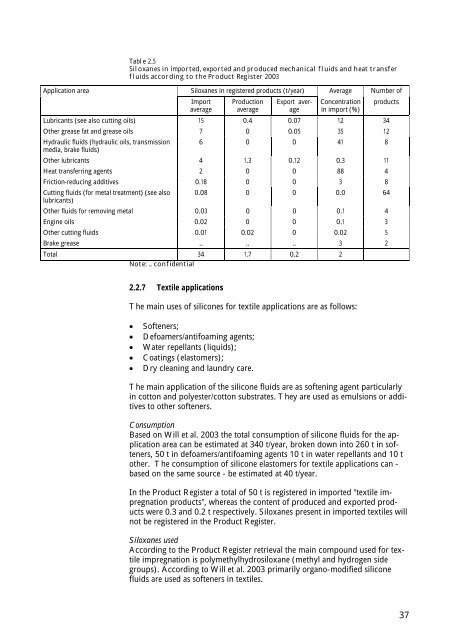No. 1031 - Miljøstyrelsen
No. 1031 - Miljøstyrelsen
No. 1031 - Miljøstyrelsen
Create successful ePaper yourself
Turn your PDF publications into a flip-book with our unique Google optimized e-Paper software.
Table 2.5<br />
Siloxanes in imported, exported and produced mechanical fluids and heat transfer<br />
fluids according to the Product Register 2003<br />
Application area Siloxanes in registered products (t/year) Average Number of<br />
Import<br />
average<br />
Production<br />
average<br />
Export average<br />
Concentration<br />
in import (%)<br />
Lubricants (see also cutting oils) 15 0.4 0.07 12 34<br />
Other grease fat and grease oils 7 0 0.05 35 12<br />
Hydraulic fluids (hydraulic oils, transmission<br />
media, brake fluids)<br />
products<br />
6 0 0 41 8<br />
Other lubricants 4 1.3 0.12 0.3 11<br />
Heat transferring agents 2 0 0 88 4<br />
Friction-reducing additives 0.18 0 0 3 8<br />
Cutting fluids (for metal treatment) (see also<br />
lubricants)<br />
0.08 0 0 0.0 64<br />
Other fluids for removing metal 0.03 0 0 0.1 4<br />
Engine oils 0.02 0 0 0.1 3<br />
Other cutting fluids 0.01 0.02 0 0.02 5<br />
Brake grease .. .. .. 3 2<br />
Total 34 1.7 0.2 2<br />
<strong>No</strong>te: .. confidential<br />
2.2.7 Textile applications<br />
The main uses of silicones for textile applications are as follows:<br />
• Softeners;<br />
• Defoamers/antifoaming agents;<br />
• Water repellants (liquids);<br />
• Coatings (elastomers);<br />
• Dry cleaning and laundry care.<br />
The main application of the silicone fluids are as softening agent particularly<br />
in cotton and polyester/cotton substrates. They are used as emulsions or additives<br />
to other softeners.<br />
Consumption<br />
Based on Will et al. 2003 the total consumption of silicone fluids for the application<br />
area can be estimated at 340 t/year, broken down into 260 t in softeners,<br />
50 t in defoamers/antifoaming agents 10 t in water repellants and 10 t<br />
other. The consumption of silicone elastomers for textile applications can -<br />
based on the same source - be estimated at 40 t/year.<br />
In the Product Register a total of 50 t is registered in imported "textile impregnation<br />
products", whereas the content of produced and exported products<br />
were 0.3 and 0.2 t respectively. Siloxanes present in imported textiles will<br />
not be registered in the Product Register.<br />
Siloxanes used<br />
According to the Product Register retrieval the main compound used for textile<br />
impregnation is polymethylhydrosiloxane (methyl and hydrogen side<br />
groups). According to Will et al. 2003 primarily organo-modified silicone<br />
fluids are used as softeners in textiles.<br />
37

















